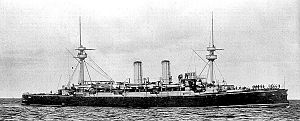Chilean cruiser Esmeralda (1896)
 Esmeralda | |
| History | |
|---|---|
| Name | Esmeralda |
| Namesake | Esmeralda (1791) |
| Ordered | 15 May 1895 |
| Builder | Armstrong Mitchell, Elswick |
| Laid down | 4 July 1895[1] |
| Launched | 14 April 1896[1] |
| Commissioned | 4 September 1896[1] |
| Decommissioned | 1930 |
| Fate | Scrapped 1930 |
| General characteristics [1] | |
| Type | Armoured cruiser |
| Displacement | 7,032 long tons (7,145 t) |
| Length | |
| Beam | 52 ft 5 in (15.98 m) |
| Draft | 20 ft 6 in (6.25 m) |
| Installed power | |
| Propulsion | 2 shafts; 2 triple expansion steam engines |
| Speed | 22.25 knots (41.21 km/h; 25.60 mph) |
| Complement | 513 |
| Armament |
|
| Armor |
|
Esmeralda was developed as a custom design by naval architect Philip Watts for the Chilean Navy during the Argentine–Chilean naval arms race.
Background and design
[edit]This Esmeralda was purchased in part with US$1,500,000 in funds garnered from the sale of an earlier protected cruiser of the same name to Japan via Ecuador.[2]
The idea for the design was based on the performance of Japanese firepower and speed in the Battle of the Yalu River.[3]
The new ship was defined by historian Adrian J. English as "the first armored cruiser to be built for any navy,"[4] and the contemporary Naval Annual called it "one of the most powerful cruisers in the world."[5] Another historian, Peter Brook, has written that Esmeralda should be classified as a lesser "belted" cruiser due to design faults present after its conversion from a protected cruiser while under construction.[6]
Service
[edit]This section needs expansion. You can help by adding to it. (October 2020) |
On 18 December 1907, the ship brought troops from Valparaíso to Iquique to repress thousands of miners from different nitrate mines in Chile's north who were appealing for government intervention to improve their living and working conditions. This later developed into the Santa María School massacre.[7]: 340
In 1910, it sailed with the frigate O’Higgins to the naval magazine of Argentina for its centenary. [3]
In 1915, the Chilean Navy claimed that Esmeralda set speed and accuracy world records in big-gun shooting. For the latter, 100 out of 100 shots hit a target.[8]
Esmeralda served in the Chilean Navy until 1930.[3]
- 1:48 scale model of Esmeralda, on display at the Swiss Museum of Transport.
See also
[edit]Notes
[edit]- ^ a b c d Brooke 1999, p. 101.
- ^ Robert Scheina, Latin America: A Naval History 1810–1987 (Annapolis: Naval Institute Press, 1987), 48; Charles R. Flint, "Fifty Years a Trader," System: The Magazine of Business 40, no. 2 (1921): 218.
- ^ a b c "Crucero". armada.cl (in Spanish). Retrieved 2023-11-21.
- ^ Adrian J. English, Armed Forces of Latin America (London: Jane's Publishing Company, 1984), 146.
- ^ E. Weyl, "The Progress of Foreign Navies," in The Naval Annual, ed. T.A. Brassey (London: William Clowes and Sons, 1896), 55.
- ^ Peter Brook, Warships for Export: Armstrong Warships, 1867–1927 (Gravesend, UK: World Ship Society, 1999), 101–02.
- ^ Carlos López Urrutia (1969). Historia de la Marina de Chile. Andres Bello. GGKEY:9XDHU6QU6DA. Retrieved 9 January 2013.
- ^ "Chileans Claim a Record". The New York Times. 11 July 1915. p. 8. Retrieved 21 April 2023.
References
[edit]- Brooke, Peter. Warships for Export: Armstrong Warships 1867–1927. Gravesend, UK: World Ship Society, 1999. ISBN 0-905617-89-4.
- Chesneau, Roger and Eugene M. Kolesnik. Conway's All the World's Fighting Ships 1860–1905. London: Conway's Maritime Press, 1979. ISBN 0-85177-133-5.
External links
[edit]- Chilean Navy site Esmeralda (1895), retrieved on 17 December 2012


 French
French Deutsch
Deutsch
